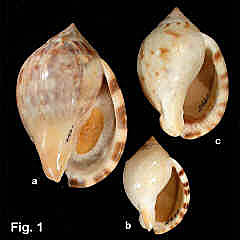|
|
|
||||||||

|
Semicassis labiatum (Perry, 1811) Description: Shell smooth, with spiral ribbing only evident on the early spire whorls, and sometimes with 3 or 4 faint spiral grooves on the base of the body whorl, especially in shells from deep water. Shoulder smooth, or bearing one, or rarely two, rows of nodules which occur only on the body whorl, not on the spire, and stop about 3 nodule widths short of the lip. Outer lip usually toothed, especially anteriorly. Columella shield lirate on inner edge, otherwise smooth, and folded over to nearly close the umbilicus; outer edge straight. Intertidal specimens have a mottled purple-brown background with darker spiral rows with superimposed white dots. Deeper water shells are lighter in colour with spiral bands of white dots. Both forms show a spiral row of brown spots below the suture. Size: Adult shells 30-103 mm high. Distribution: Caloundra, Qld, to Port Macdonnell, SA. Also occurs in New Zealand, South Africa and central South America. Habitat: Intertidal down to about 100 m. Intertidal shells are found buried in sand pockets amongst rocks. Comparison: Intertidal shells are readily distinguished from other species by their purple-brown coloration and smooth shell. Some deep water specimens are difficult to distinguish from Semicassis pyrum, but can usually be separated by the spiral bands of white dots, absent in S. pyrum. Abbott (1968) suggests that hybridization occurs between S. pyrum and S. labiatum resulting in shells intermediate between the two species. Synonym: The name Xenogalea insperata Iredale, 1927 was given to the nodulose form from NSW. Remarks: Intertidal shells are purplish-brown in colour with a yellow columella shield. Deeper water specimens are smaller in size, lighter in colour with prominent spiral rows of white dots. Figs. 1a, 2a: South of East Beach, Kiama, NSW (DLB1064) Figs. 1b, 2b: Catherine Hill Bay, NSW (DLB2535) Figs. 1c, 2c: Collaroy Beach, NSW (DLB2540) Fig. 3: Live animal (Inscription Point, Kurnell, 0.2 m depth, 2009) (Photo: Jack Hannon Copyright: Jack Hannon)
|
||||||||
|
Copyright Des Beechey 2000 |

